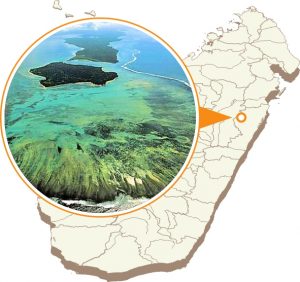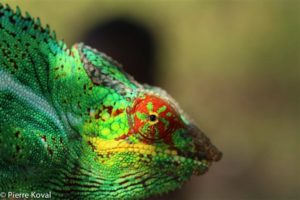North of Tamatave - in the realm of "Zana-Malata
The Zana-malata are the mixed-race children of Western pirates and slave traders who roamed the East Coast, and the daughters of local chiefs. The most famous of these "descendants of the mulattos" 
As the son of a clerk of the French East India Company Jean René proclaimed himself king of Mahavelona and Toamasina in 1811 and hunted down the Zana-malata. In 1817, he accepted the suzerainty of Radama I, to retain local power, and helped him conquer the southeast. Later he defended the Mahavelona Fortress victorious against the French and English.
Botanical Garden of the Ivoloina Valley
13 km from Toamasina and accessible by a path that branches off the RN5 to reach the coast, the Ivoloina Valley used for the cultivation of food.

King Jean René rests on the Manahoro Plateau, an eminence that dominates the Toamasina Plain and the mouth of the Ivoloina River.
Betampona Forest Station
55 km northwest of Toamasina via Sahandahatra and Ambodiriana located, this station, served by a seasonal track, is the laboratory of a large World Bank project aimed at involving the population in environmental protection (halting deforestation, especially by changing agricultural practices).
Pheasantiana Necropolis
30 km from Toamasina away, on the RN5, Fasandiana (fasana means "grave"), the wooden buildings of the Ravinala, built on the beautiful beach to the right of the road, house temporary burials of Betsimisaraka fishermen. The coffins - made from overturned pirogues - point toward the ocean, a mysterious expanse from which the ancestors one day came.
Mahavelona (Foul Pointe)
If marauding sharks make swimming difficult in Toamasina, the Ivorian beaches of Mahavelona - 60 km north on the RN5 - and the turquoise waters of its lagoon it soon became a seaside resort.

In the 18th century, the French established a trading post there, which they called Foulpointe, from Hopeful Point, the name given to the English Pirate Thomas White had given the place.
Manda Fortress
This Merina Citadel, whose remains guard the northern entrance to the city, was built between 1822 and 1831. It is one of the five forts built by Radama I to assert his sovereignty on the east coast against the French and English.
A circular enclosure 6 meters high and 4 meters thick at its base, doubled by a deep ditch, protected the four buildings of the Manda: the officers' residence, the barracks of the troops, the arsenal and the prison.
As in Ambohimanga cement made of sand, crushed coral and egg white was used to grout the stones. The fort was armed with English mortars, then with cannons fired from Jean Laborde in Mantasoa were cast.
Decommissioned after 1898, it became a den of robbers and a retreat for the independenceists and their families during the 1947 uprising. This historic monument, gradually dismantled for the needs of local construction, especially that of the RN5 in the 1950s, has been listed since 1975.
Mahavelona Cemetery
The old cemetery, which is gradually being reclaimed by vegetation, has a romantic atmosphere and is home to interdicts, slave traders and other adventurers from the 17th to 19th centuries. One of the most visited funerals is that of Couillandeau de la Touche, surgeon to the King of France, who died at Mahavelona in 1766.
Mahambo
95 km from Tomasina hides this village, representative of the east coast, with its wooden houses and 
Walking in the forest, swimming, snorkeling near the coral reef, pirogue rides with the Betsimisaraka fishermen or lazing... Temptations do not mark!
Mahambo is also the meeting place for surfers. Like Mahavelona, the place was equipped with a merina fortress, but only scattered stones remain.
Fenoarivo Atsinanana
In Fénérive-est, 105 km from Toamasina, this is surrounded by vast plantations of Coffee trees, Cloves and Lychees surrounded main prefectural city one of the most important agricultural centers in the region.
In Fenoarivo (which is more than a thousand) proclaimed itself Ratsimilaho 1712 to the king of the Betsimisaraka, after chasing Ramanana and his men away from the fortified hill of Vohimasina.
At this height, 2 km to the southwest, one can still see the remains of a fort built by Radama I in the 1820s.
Soanierana-Ivongo
From this fishing village, 58 km from Fenoarivo away, you can look for Nosy Boraha (Sainte-Marie) embark or the Marimbona go up in a pirogue under a beautiful forest cover.

It ends at the Masoala Peninsula and is very difficult to reach by jeep. Breathtakingly beautiful landscapes and intact rainforests are still preserved there.
The hotel offer is, as they say, "limited". During the day you can take a pirogue up the Maharibona River and visit the clove distilleries.
Myth Betsimisaraka
According to tradition, Tovo, the first man, stole the rice from heaven with the complicity of Noro, the youngest daughter of God, whom he had seduced. Unbeknownst to her father, Noro gaved a rice goose and revealed to the chosen one in her heart how to grow and prepare swamp rice or rain rice (vary horaka).
To punish the people for their impudence, according to the myth, God ordered the wild boars, rats and birds to come regularly and plunder the rice fields.
Nosy Akoho (Nosy Ilaintsambo)
The "Island of Chickens", is an old pirate hideout located not far from the Vohimasina fortress, is a sacred place for the descendants of the zana-malata.
This small island was once a port, after being a den of pirates.

There is one of its most important cemeteries with the graves of the Zafindrabe family from the dynasty of King Ratsimilaho (17th century).
Inside the island, a huge cast-iron pot (about one meter in diameter) was used to prepare royal meals during the Zanamalata festivals. It is still an object of worship today, as people come to gather at the site of the pot.
On the reefs surrounding the island, Thomas White, the future father of King Ratsimilaho, ran aground before the love between a princess and a pirate gave birth to a Métis dynasty.
The Betsimisaraka come by pirogue to honor these brave ancestors and gather in the place where royal feasts were once prepared in huge cast-iron pots, like the one in the prefecture gardens in Fenoarivo.


















 Villa Sibylle Antananarivo (Madagascar)
Villa Sibylle Antananarivo (Madagascar)

